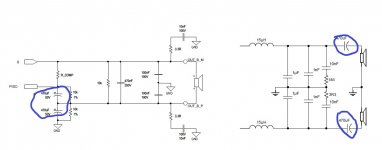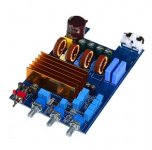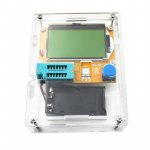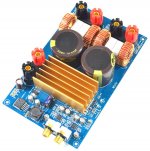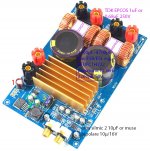Chermann: I hope these upload correctly.
On both amp & power supply
turion64 (aka Pete)
thnaks pics are fine
Class D does not differ from AB or A, if the power supply is dirty, weak or slow, you hear it in the sound quality.
IMO this is also a main reason for different sounding DAC´s , CD-players and relatives.
Products with few, large (fake) electrolytics may profit more from a change than those with many small, no name (non audiophile) capacitors.
I think most important are the capacitors nearest to the switching transistor, so in most cases close to the D-amp chip.
I trust the producers of universal, not special "Audio" SMPS more to use decent parts, then the amp makers that in most cases put fake "audio grade" parts on their boards.
PS I would love to hear more about the "reference design"!
yes ...i agree
I just ordred just for fun the cheapes TPA3255 2.1 board. I payed 35$ shipping inlcuded. It has the same layout as RuslanK35 but without the bluetooth oart
I want to modd it to. Change outputfilter and SE capacitos.
I the datasheet the use 470uF capacitor but in the EVM the use big 1500uF.
What will happen if I take 330uF or bigger? I have 330uF 35V LXY for SE-output. What is better:
Left or right output. Left is from TAS5630 and right from TPA3255
I plan to use:
Wima MKS2-63V 1,0µF
Wima FKP2-250V 1,0nF or FKS2-400V 1,0nF
Wima MKP2-100V 10nF
-> Change SE output coil to 15uH????
What do you thing about this modifications?
Are the stock coilas really 7uH and 15uh? Or have they the same value?
I want to modd it to. Change outputfilter and SE capacitos.
I the datasheet the use 470uF capacitor but in the EVM the use big 1500uF.
What will happen if I take 330uF or bigger? I have 330uF 35V LXY for SE-output. What is better:
Left or right output. Left is from TAS5630 and right from TPA3255
I plan to use:
Wima MKS2-63V 1,0µF
Wima FKP2-250V 1,0nF or FKS2-400V 1,0nF
Wima MKP2-100V 10nF
-> Change SE output coil to 15uH????
What do you thing about this modifications?
Are the stock coilas really 7uH and 15uh? Or have they the same value?
Attachments
Yes, the values make sense.
This board seems to use 2x SE and 1x bridged output. The bridged part uses 2x7uH, the SE 1x 14uH, wich gives the same result.
This board seems to use 2x SE and 1x bridged output. The bridged part uses 2x7uH, the SE 1x 14uH, wich gives the same result.
Argh, what's the sense with the left drawing in #883? The potential at both speaker terminals appear to average at half the PVDD level??
Best regards!
Best regards!
But from older post the value could be false... Some bad sound quality... or ist it from an other way.
Are the my proposed capacitos good choise? Some said only MKP but MKP are very bigg and wont fit int this little amp^^
TPA3255 use cap in serie
TAS5630 use cap voltagdividor
Whats better?
This TPA3255 use also voltage dividor.
Are the my proposed capacitos good choise? Some said only MKP but MKP are very bigg and wont fit int this little amp^^
TPA3255 use cap in serie
TAS5630 use cap voltagdividor
Whats better?
This TPA3255 use also voltage dividor.
even a small MKP in parallel to the electrolitc will help, maybe soldered at the back of the PCB. This way you get better high frequency reproduction, maybe.
I would leave any 2.1 board allone and get 2 identical 2.0 boards plus a decend x-over (car audio or DSP) you can adjust to your speakers. This will make a much better 2.1 or 2.2 than these unpercise Chinese x-over missconstructions.
I would leave any 2.1 board allone and get 2 identical 2.0 boards plus a decend x-over (car audio or DSP) you can adjust to your speakers. This will make a much better 2.1 or 2.2 than these unpercise Chinese x-over missconstructions.
I got interested about this 2.1 TPA3255 chip amp from ebay, but not sure how it works. The pots on front panel are just volume controls? the bass one for sub and treble one for stereo satelites and last one is master volume for all channels together or what?
does it contain at least some basic built-in crossover? LP for sub and HP for satelites?
does it contain at least some basic built-in crossover? LP for sub and HP for satelites?
There is one 2.1 with 5 pot´s and a switch between them for HP on/off. This one has got some positive critic. Many others (all?) have no HP.
Inspired by the conversation on this forum I just bought my first class d - Chinese 3255 amp.
Tested it with a laptop power supply and it works. Later I will be using 36v 400w power supply.
So the question is what are the best basic mods that can be done to it?
-Should the big Samwha caps (4700µF) be changed to ELNA 3900µF 100V that are on some pictures or something better?
-Are there some other components that are easy to change and can improve sound quality?
I have read the whole topic, but haven't understood everything. I am not experienced with electronics or audio.
😕
Tested it with a laptop power supply and it works. Later I will be using 36v 400w power supply.
So the question is what are the best basic mods that can be done to it?
-Should the big Samwha caps (4700µF) be changed to ELNA 3900µF 100V that are on some pictures or something better?
-Are there some other components that are easy to change and can improve sound quality?
I have read the whole topic, but haven't understood everything. I am not experienced with electronics or audio.
😕
Attachments
So I modded my TPA3255 board.
I change output components like datasheet.
I add bigger rail caps.
Powerd by TL494 Boost converter. Input 18V (5S4P Panasonic Li-Ion) output 40V for the amplifier.
I have the bob when turning on and off. But for my usage its not really problematic.
I think its much more powerfull than TPA3116.
I change output components like datasheet.
I add bigger rail caps.
Powerd by TL494 Boost converter. Input 18V (5S4P Panasonic Li-Ion) output 40V for the amplifier.
I have the bob when turning on and off. But for my usage its not really problematic.
I think its much more powerfull than TPA3116.
Attachments
-
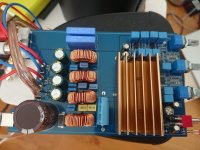 WhatsApp Image 2019-08-29 at 15.50.19.jpeg247.6 KB · Views: 242
WhatsApp Image 2019-08-29 at 15.50.19.jpeg247.6 KB · Views: 242 -
 WhatsApp Image 2019-08-29 at 15.50.19(1).jpeg229 KB · Views: 234
WhatsApp Image 2019-08-29 at 15.50.19(1).jpeg229 KB · Views: 234 -
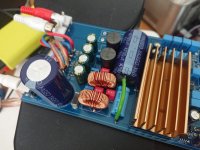 WhatsApp Image 2019-08-29 at 15.50.19(2).jpeg220.3 KB · Views: 245
WhatsApp Image 2019-08-29 at 15.50.19(2).jpeg220.3 KB · Views: 245 -
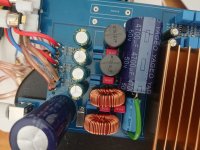 WhatsApp Image 2019-08-29 at 15.50.19(3).jpeg254 KB · Views: 854
WhatsApp Image 2019-08-29 at 15.50.19(3).jpeg254 KB · Views: 854 -
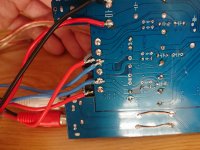 WhatsApp Image 2019-08-29 at 17.52.49.jpeg242.1 KB · Views: 892
WhatsApp Image 2019-08-29 at 17.52.49.jpeg242.1 KB · Views: 892 -
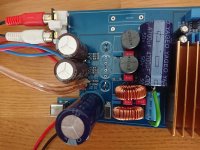 WhatsApp Image 2019-08-29 at 17.52.49(1).jpeg256.6 KB · Views: 870
WhatsApp Image 2019-08-29 at 17.52.49(1).jpeg256.6 KB · Views: 870 -
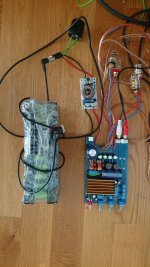 WhatsApp Image 2019-08-29 at 17.52.49(2).jpeg234.6 KB · Views: 889
WhatsApp Image 2019-08-29 at 17.52.49(2).jpeg234.6 KB · Views: 889
I received my TPA3255 from Yuan Jing.
Looks like mine is like Swefos's in his single image above.
Meanwell 48v 600W PSU to the YJ TPA3255.
The amp has decent connectors . Binding posts for the speakers take banana plugs.
Same connectors used for power.
Decent RCA sockets. I plugged in Squeezebox touch , no pre amp , as it has volume control
I started with sacrificial car spkrs, and quickly graduated to Yam NS1000
Bass is excellent
Nice full mids , smooth if a tad veiled highs.
Not harsh or fatuiging at all.
Listened at decent volumes for abt 2 hrs.
Heatsink barely a hint of warmth to touch.
PSU fan noisy but the casing stayed very cool.
I am really impressed as things are now, untweaked.
Looks like mine is like Swefos's in his single image above.
Meanwell 48v 600W PSU to the YJ TPA3255.
The amp has decent connectors . Binding posts for the speakers take banana plugs.
Same connectors used for power.
Decent RCA sockets. I plugged in Squeezebox touch , no pre amp , as it has volume control
I started with sacrificial car spkrs, and quickly graduated to Yam NS1000
Bass is excellent
Nice full mids , smooth if a tad veiled highs.
Not harsh or fatuiging at all.
Listened at decent volumes for abt 2 hrs.
Heatsink barely a hint of warmth to touch.
PSU fan noisy but the casing stayed very cool.
I am really impressed as things are now, untweaked.
hi swefos
hi hihgcut28
this board is the 2.0 and its existing 2 versions of that. the newer one what you have has the voltage regulator 2575-12T, no LM317 is existing. this regulator sets the voltage to the needed 12V of the op amps and other inputs of the tpa3255.
both boards have the same regulator version- i mean that the max voltage of 40V should not be exceeded. it can work but you have just the guarantee at the "HV" version of this chip - to push more voltage without damaging the regulator.
https://www.diyaudio.com/forums/class-d/309813-wrong-tpa3255-81.html#post5812253
i tried a lot of things with the help of others....i know its a lot of pages but read the complete thread - you will learn a lot.....and yes you will not understand at the first time 😉😀
chinese borads..
first - you do not get the power out at this boards what is possible like TI EVM or 3e boards. this design is smaller and here are some compromisses done. never the less for home use and party you will be satified.
the caps are after some weeks playing with the original not really the best. a decoupling cap must have a low ESR/ESL at higher frequencies and this elnas shanwa waht ever are maybe origin but are nice for other amps or other usage.
change this for e.g. 2200µf - 4700µF with low ESR/ESL - normally good smps caps can handle this.
e.g. EEUFC1H222 panasonic Fc serie 2200µF/50V ....about 2,50 euro
the smal polymer - but this out and use the recommended caps at the regulator and for the input of the TPA3255 chip (4 pcs) use elna silmic 2 10µF or my favorits muse bipolare 10µ/16V.
i treid the panasonic bipolare - P1163-ND - but not as good as the green muse
the output filter are aout 13µH coils. i would not recommend to change this in the first step. change the grey output filter caps with better one -eg. TDK EPCOS or similar 1µ or 0,68µ/ 250V.
the opamps are maybe not real TL072 - so this could be change tho NE5532 or i use the AD8599 or better AD1602.
i had about 8 boards and at the first series the quality was ok - but the second (different seller) i was not happy during soldering - so use as much flux as you can the copper layers are very thin and do not overheat.
after modification....the TPA3255 has a very quiet sound - its "dark" and relaxed .....have fun
the pop/on/off - solution - you can handle with doctor´s circuit..
TPA3255 - all about DIY, Discussion, Design etc.
chris
hi hihgcut28
this board is the 2.0 and its existing 2 versions of that. the newer one what you have has the voltage regulator 2575-12T, no LM317 is existing. this regulator sets the voltage to the needed 12V of the op amps and other inputs of the tpa3255.
both boards have the same regulator version- i mean that the max voltage of 40V should not be exceeded. it can work but you have just the guarantee at the "HV" version of this chip - to push more voltage without damaging the regulator.
https://www.diyaudio.com/forums/class-d/309813-wrong-tpa3255-81.html#post5812253
i tried a lot of things with the help of others....i know its a lot of pages but read the complete thread - you will learn a lot.....and yes you will not understand at the first time 😉😀
chinese borads..
first - you do not get the power out at this boards what is possible like TI EVM or 3e boards. this design is smaller and here are some compromisses done. never the less for home use and party you will be satified.
the caps are after some weeks playing with the original not really the best. a decoupling cap must have a low ESR/ESL at higher frequencies and this elnas shanwa waht ever are maybe origin but are nice for other amps or other usage.
change this for e.g. 2200µf - 4700µF with low ESR/ESL - normally good smps caps can handle this.
e.g. EEUFC1H222 panasonic Fc serie 2200µF/50V ....about 2,50 euro
the smal polymer - but this out and use the recommended caps at the regulator and for the input of the TPA3255 chip (4 pcs) use elna silmic 2 10µF or my favorits muse bipolare 10µ/16V.
i treid the panasonic bipolare - P1163-ND - but not as good as the green muse
the output filter are aout 13µH coils. i would not recommend to change this in the first step. change the grey output filter caps with better one -eg. TDK EPCOS or similar 1µ or 0,68µ/ 250V.
the opamps are maybe not real TL072 - so this could be change tho NE5532 or i use the AD8599 or better AD1602.
i had about 8 boards and at the first series the quality was ok - but the second (different seller) i was not happy during soldering - so use as much flux as you can the copper layers are very thin and do not overheat.
after modification....the TPA3255 has a very quiet sound - its "dark" and relaxed .....have fun
the pop/on/off - solution - you can handle with doctor´s circuit..
TPA3255 - all about DIY, Discussion, Design etc.
chris
Last edited:
Thank you for your answer Chris!
I read about that high voltage problem and because of that decided to use 36V power supply.
Are the other things right that I draw to the picture like all 6 of the input caps are the same?
I read about that high voltage problem and because of that decided to use 36V power supply.
This I don't fully understand. Can you be more specific about what components to use? I attached a picture to this post with numbers 1, 2 and 3 that are unclear for me.the smal polymer - but this out and use the recommended caps at the regulator and for the input of the TPA3255 chip (4 pcs) use elna silmic 2 10µF or my favorits muse bipolare 10µ/16V.
i treid the panasonic bipolare - P1163-ND - but not as good as the green muse
Are the other things right that I draw to the picture like all 6 of the input caps are the same?
Attachments
Thank you for your answer Chris!
I read about that high voltage problem and because of that decided to use 36V power supply.
This I don't fully understand. Can you be more specific about what components to use? I attached a picture to this post with numbers 1, 2 and 3 that are unclear for me.
Are the other things right that I draw to the picture like all 6 of the input caps are the same?
hi
cap 1 is directly after the power supply socket - and has bad ESR/ESL - get it out and find something new with 33µ - 100µF /50 -63V
cap 2 are for the small ams1117 3,3V - this regulator produce the digital 3,3 volts for the TPA3255 chip - llok at the datasheet and choos the correct -new one. but you can keep this in the first step
cap 3 is the output cap on the LM2575 regulator - keep this in the first step - the coil "220= 22µH" build togeter with this cap the output LC filter of the regulator - i changed to 221 but i am not really sure if this is much better. according to the datahseet with the needed curent its better with 220µH (221) but expert mentioned that not really much better.....sorry but i did no measurements.
yes your 6 caps are the input caps - the 2 caps directly left/right at the rca connector are the input caps to the amp board = op amps input.
the other 4 caps are the input INA, INB,INC and IND of the TPA3255 chip.
i had one board with 6 elna silmic 2 10µ/16V -cheap and good sound.
i try a board with 2 bipolar at the rca input caps + 4 elna silmic - much better. - outswing of natural instruments are better, if your speakers are good! you should try foil caps at this position = bipolar
the 4 caps to the TPA3255 ....i read that its possible to shorten this and go direct into the chip - if your source has a AC coupling (to avoid DC into the amp!)...i didn´t try this.
be aware that the smd solder/desolder is very delicate ! + the quality of this traces are not the best !
the other caps are right !....well done ;-)
chris
Would it not be safer to use 32V 6A adapter for generic chinese TPA3255 amps with a volume knob and a power switch?
TPA3255 amp boards do not have a volume knob. I don't know how I would control volume without a volume knob.
TPA3255 amp boards do not have a volume knob. I don't know how I would control volume without a volume knob.
i try a board with 2 bipolar at the rca input caps + 4 elna silmic - much better.
I ran out of foil caps and decided to use 10uF 35v Elna Silmic II's on the de-coupling caps between the opamps and the TPA3255 and the combo sounds great. I only had 2.2uF MKS caps (vs the spec'd 10uF) but the bass sounds just fine.
Elna Silmic's do sound great and are very inexpensive.
I ran out of foil caps and decided to use 10uF 35v Elna Silmic II's on the de-coupling caps between the opamps and the TPA3255 and the combo sounds great. I only had 2.2uF MKS caps (vs the spec'd 10uF) but the bass sounds just fine.
Elna Silmic's do sound great and are very inexpensive.
What is the 12V voltage regulator on your TPA3255 amp board?
What is the output voltage of your power supply?
I ran out of foil caps and decided to use 10uF 35v Elna Silmic II's on the de-coupling caps between the opamps and the TPA3255 and the combo sounds great. I only had 2.2uF MKS caps (vs the spec'd 10uF) but the bass sounds just fine.
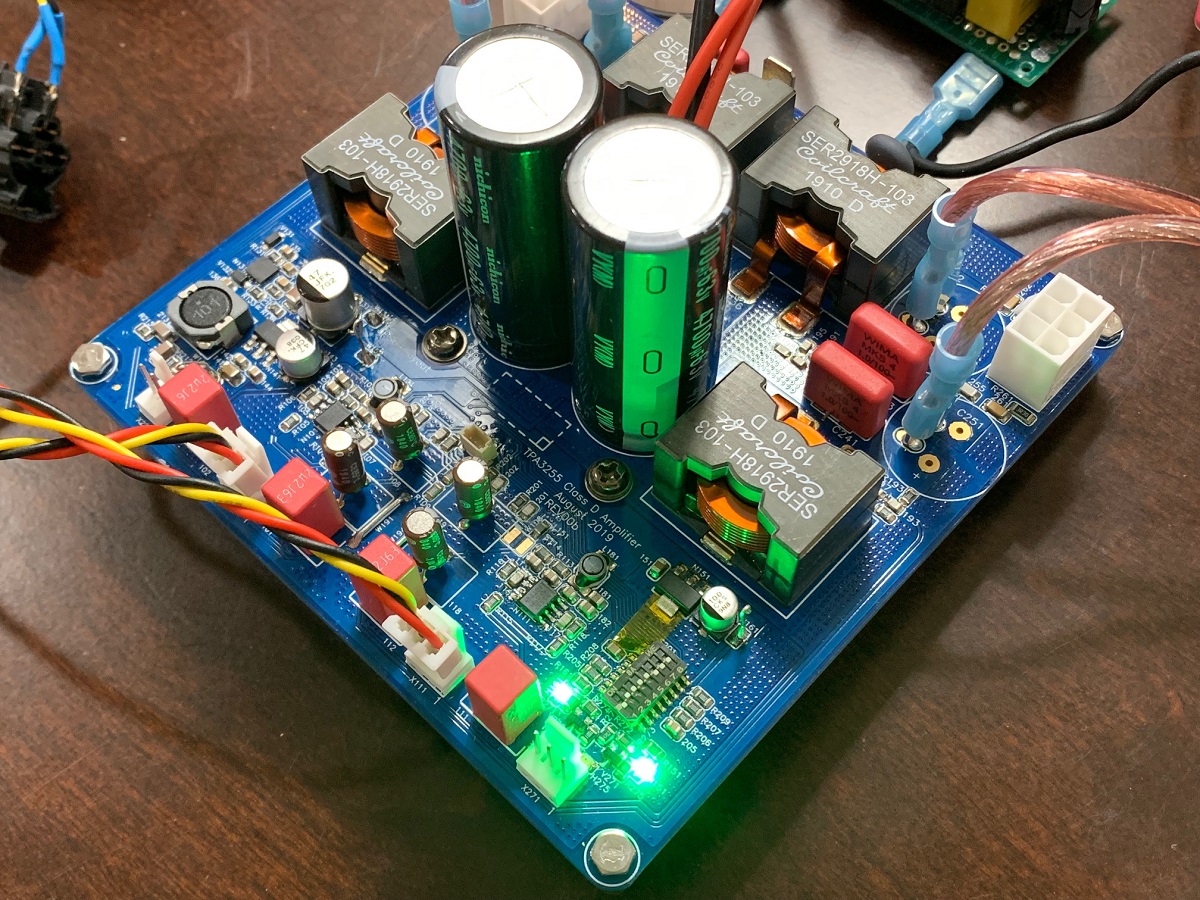
Elna Silmic's do sound great and are very inexpensive.
did you try the bi polare green muse by nichicon? 10µ/16V more expensive but in my opinion better sound.
chris
- Home
- Amplifiers
- Class D
- What is wrong with TPA3255?
